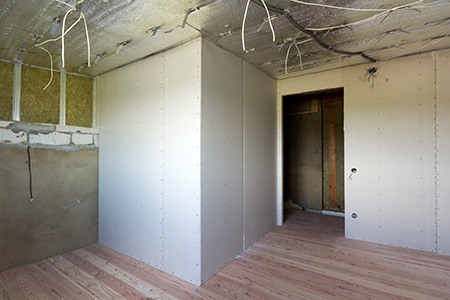How Much Weight Can Drywall Hold? (6 Factors)
Author: Omar Alonso | Editor: Omar Alonso
Review & Research: Jen Worst & Chris Miller

Drywall is a popular building material to construct and finish interior walls and ceilings. It's strong and can hold plenty of weight when you install it correctly. But how much weight can drywall hold?
How much weight can a nail hold in drywall? Drywall adequately adhered to a stud can hold up to 55 pounds in a single spot. This limit doesn't require any additional reinforcement.
If you install extra supports like screws, brackets, or anchors, drywall can easily hold up to 100 pounds of vertical weight and more when the studs are used. It's an excellent material for hanging shelves, pictures, and other decorations.
Factors that Affect How Much Weight Drywall Can Hold
Several factors can affect how much weight drywall holds. If you're building or renovating a room, consider if you'll hang heavy objects in the future. The answer to this decorating issue will influence the materials you select for the construction work and where you'll place furniture.
Drywall Thickness

How much weight can you hang on drywall? The drywall thickness significantly impacts how much weight it can hold. Thicker drywall has a higher density, making it stronger and able to hold more weight. Thinner drywall has a lower density and can't handle heavy objects.
A thicker drywall panel, such as 5/8-inch drywall, uses more material. The material builds a stronger foundation that increases its strength, helping it hold more weight.
Thicker drywall is ideal in commercial and high-traffic areas, where it is more likely to encounter bumps and heavy loads.
Though thick drywall can handle a lot of weight, manufacturers don't specifically design it to support heavy loads. You'll want to provide additional support for heavy items, such as:
- Shelves
- Mirrors
- Large pieces of art
- Cabinets
Hanging heavy items on drywall requires proper installation, including sturdy fasteners and load-bearing framing to provide a solid foundation for the drywall.
Type of Drywall Anchors & Fasteners Used

Drywall is a relatively weak material, so it can only handle a limited amount of weight without reinforcements. Fasteners strengthen the material and keep it attached to the framework. The types of fasteners you use to attach the drywall to the framing can affect how much weight it holds, just as much as they types of drywall anchors you use can..
Heavier-duty fasteners such as screws, nails, and toggle bolts support more weight than lighter-duty fasteners such as glue and plastic anchors. In general, screws are more substantial and provide a better hold than nails due to the threading. Any threaded anchor can handle up to 75 pounds, and by introducing more anchors you can increase that number.
The quality of the fastener is also essential when answering how much weight can drywall hold. Higher-quality fasteners will be able to support more weight than lower-quality fasteners. Expansion anchors hold the least weight, maxing out at 25 pounds. Since they're so light, you can't use these fasteners on ceilings.
Know how to remove drywall anchors without doing extra damage because patches will compromise the integrity of the drywall and their ability to hold as much weight later, close to the previous holes.
Spacing of the Fasteners & Anchors

The spacing of the fasteners affects how much weight the drywall holds. If the fasteners are too far apart, the drywall might not support the weight of the hung object. The closer you space the anchors, the more support they provide. With sturdy drywall in place, you can easily hang more weight.
Type of Framing
The type of framing used to hang drywall directly impacts how much weight the drywall holds. Generally speaking, the thicker and heavier the frame, the more weight it can withstand, especially if you pass through the drywall into the studs.
For example, two-by-four framing can typically hold up to 40 pounds per linear foot. Two-by-six framework can hold about 60 pounds per linear foot. Metal studs can handle up to 80 pounds per linear foot. A wonderful tool to help you calculate the sag produced by a evenly distributed load on various materials is the Sagulator.
These are just examples for evenly distributed loads and not items hanging off of screws and nails driven into them. The main point is thicker wood is stronger and metal of a sufficient thickness to be a wAll frame is stronger than any wood frame.
Keep these weight constraints in mind as you choose your framing material. You want to ensure your walls can hold the desired weight. Consider, too, that regardless of your stud distance, which should be 16 inches, if you aren't screwing or nailing into a stud this will drastically reduce the weight the drywall can hold, even with anchors (which can still be enough).
Load Distribution
The way the drywall distributes the load also plays a role in how much weight it can hold. For example, a load spread over a large area puts less stress on the drywall. If you concentrate a load in one spot, you'll strain that location and risk damaging the drywall and possibly the frame.
The load distribution determines how much weight is in one area versus another. The drywall can hold more weight if you can distribute a load evenly over a large area. When you concentrate a lot of weight in one place, you need to ensure you're using thick drywall and the best fasteners spaced close together.
Proper load distribution ensures the drywall can withstand the weight of the objects you attach to it. How many pounds can drywall hold? Well, how distributed is the load?
Quality of the Drywall
The quality of the drywall, like the brand and the manufacturing process and the specific types of drywall being used, impacts the weight it holds. Some drywall uses reinforced materials, making them specifically-designed to hold more weight than others. You can also install high-quality, fire-resistant drywall for maximum security.
Remember that most manufacturers don't design drywall to support heavy loads. You don't want to hang heavy items like large mirrors, shelves, or cabinets without proper installation and support. If you're unsure about your drywall quality, consult with a professional. They'll ensure you follow the best installation guidelines for the ideal hanging weight.
Estimating Weight Capacity of Drywall

How much weight can drywall hold? Estimating the weight capacity of drywall is a bit tricky due to the above factors. There are a few general guidelines you can follow based on drywall thickness. Remember that these are all estimates, and the weight capacity can vary based on your specific job site.
The weight capacity is for static weight, so it's not designed to hold any weight that moves around. If you plan to install something that moves or shifts, such as a ceiling fan, consult with a professional contractor. They'll ensure you install the drywall safely and securely.
Weight Capacity of 1/2-Inch Drywall
How strong is drywall? You can determine the weight capacity of 1/2-inch drywall by a combination of factors, such as:
- The type of drywall used
- The quality of the installation
- The strength of the framing behind it
Typically, standard 1/2-inch drywall can hold five to ten pounds per square foot. This amount means that a four-by-eight sheet of standard 1/2-inch drywall, which is 32 square feet, could hold about 160 to 320 pounds.
Weight Capacity of 5/8-Inch Drywall
The weight capacity of 5/8-inch drywall is higher than 1/2-inch drywall due to its thicker core. However, the same factors affect its weight capacity as outlined above.
Standard 5/8-inch drywall can hold up to 10 to 15 pounds per square foot. This figure means that a four-by-eight sheet of standard 5/8-inch drywall could hold 320 to 480 pounds.
Weight Capacity of 3/4-Inch Drywall
The weight capacity of 3/4-inch drywall is even higher than both 1/2-inch and 5/8-inch options. This type of drywall has the thickest core.
Standard 3/4-inch drywall can hold up to 15 to 20 pounds per square foot. This number shows that a four-by-eight sheet of standard 3/4-inch drywall could hold 480 to 640 pounds.
Tips for Installing Heavy Items on Drywall

Even if drywall isn't as sturdy as you hope when it comes to hanging heavy items, it's still possible with proper precautions. Before you start hammering or drilling, consider the following tips and tricks.
- Choose the right hardware. When it comes to hanging heavy items on drywall, make sure you invest in the right hardware. Heavy-duty drywall anchors, such as toggle bolts and molly bolts, are your best bet for hanging heavier items.
- Pre-drill holes. Pre-drilling the holes for your drywall anchors will make installation much easier. It will also help to reduce the chances of the drywall cracking or crumbling.
- Use a level. Use any types of levels to make sure the item is properly aligned before you begin drilling.
- Use wall studs. If possible, hang the item on wall studs. This will provide extra support and reduce most of the strain on the drywall. This is a must for items the weight of a TV, for instance. How far apart are studs? 16 inches on center.
- Use multiple anchors. When hanging heavy items on drywall, use multiple anchors to spread out the weight and prevent the drywall from pulling away from the wall.
My suggestion is to always go for over-support. Use anchors that can manage more weight, use more anchors than needed if possible, and so forth. We're all always better safe than sorry.
So, How Much Weight Can Drywall Hold? It Varies!
Overall, drywall is a great material for many applications. It's capable of holding a substantial amount of weight. Depending on the size, thickness, and where you install it, and what anchors and fasteners you use, drywall can hold anywhere from a few pounds to hundreds of pounds.
When you install drywall, check the manufacturer's specifications for the weight capacity. Always use appropriate anchors for the ideal supported weight, as this process prevents drywall from tearing off the frame. So how much weight can drywall hold when hanging wall items? You could say 50 pounds with nails or screws, 100 pounds with drywall anchors, and more if you screw into the studs.



